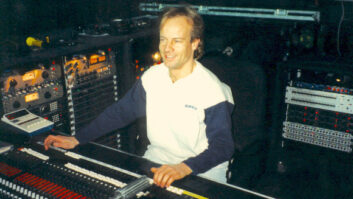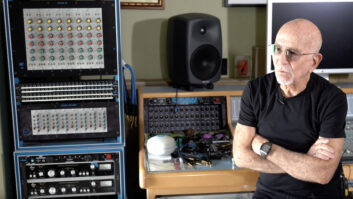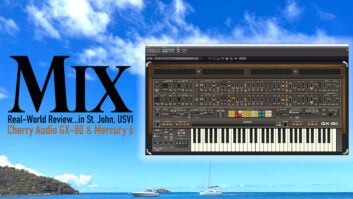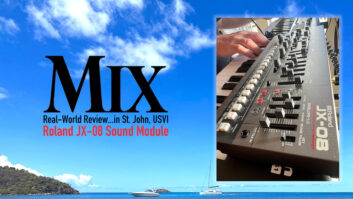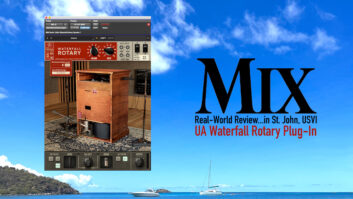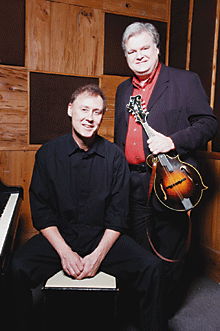

The recently released collection of songs from Ricky Skaggs and Bruce Hornsby has its genesis at a rinky-dink show that took place in the small northern New York town of Horseheads in the mid-’80s. “We played an outdoor music festival together, and the promoter had done such a poor job promoting the show that there was probably more band and crew at the gig than there were people,” Skaggs recalls with a laugh. “I did my show and went back to my little dressing room and Bruce came and knocked on the door.”
After expressing his affection for Skaggs’ music, Hornsby invited the bluegrass multi-instrumentalist to join him during his set. The two played together on that show and have crossed paths a handful of times since, including an appearance on Skaggs’ show at the legendary Ryman Auditorium in Nashville and recording a track together for the Bill Monroe tribute album Sing the Songs of Bill Monroe.
Friends and collaborators Bruce Hornsby (L) and Ricky Skaggs
“We recorded ‘Darling Corey,’ which [Monroe] and his brother did back in ’36 or ’37,” Skaggs reports. “Bruce had been doing that song in his show a little bit, so we did a bluegrass treatment and it was so much fun. It had this wonderful mixture of Bill Evans’ chord structure and bluegrass Bill Monroe. It had what we call ‘stank’ about it. It came together so quick, we looked at each other, and I said, ‘Man, we gotta do more of this, maybe do a whole album. Would you be up for that?’”
Hornsby was, and after a label shuffle the duo got back together. “We really had a heart to try to be creative and do something from start to finish, try to bring new material to it but also try to find some old things that we could rearrange in a way where it would fit both of our personalities and both of our backgrounds,” Skaggs says.
With that in mind, Hornsby, Skaggs and Skaggs’ band Kentucky Thunder — fiddler Andy Leftwich, tenor vocalist and rhythm guitarist Paul Brewster, bassist Mark Fain, banjo ace Jim Mills, lead guitarist Cody Kilby, and baritone vocalist and rhythm guitarist Darrin Vincent — convened at Skaggs Place Studio (formerly known as Superior Studios and Acorn Studios) in Hendersonville, Tenn., to get to work. Hornsby did some editing and vocal overdubs at his studio in Williamsburg, Va., but most of the record was tracked at Skaggs Place. The entire process took around a year, including the time each artist toured with his own act.
The first step, Skaggs says, was “making sure we didn’t cut something, and say, ‘Man, radio is really going to go after this.’ We let that be exorcised from our thinking. That was the great part of cutting this [album]. We didn’t have any of that ever come up. Bruce is a master of pushing that envelope of going a little bit farther, a little bit farther and making you love it on the way.”
Skaggs’ job as co-producer was to bring the sound back to center, just as Hornsby’s was to push it. The key, though, was to make sure the songs were strong. “Then when it came time to have fun and play, it was like ‘take off the handcuffs,’” Skaggs says. “We just played, going as far out as we want to go, but yet keep the integrity of the music. That was really the first line of business.”
Skaggs gives considerable credit to Kentucky Thunder. “They can push the envelope and play traditional bluegrass music. They’re always ready to take off and play stuff that you have never heard Bill Monroe play or Flatt & Scruggs,” he says. “Their virtuosity is so great that they can play really out-there kind of stuff when they really want to, so I don’t think we were working with musicians who really could only do bluegrass.”
Hornsby says of the album, “It’s bluegrass-tinged, no doubt, but it’s also pushing it in certain ways. Like I wrote a new tune called ‘Gulf of Mexico Fishing Boat Blues’ that is a bluegrass tune in 5/4. We also recorded two Roscoe Holcomb songs that Ricky sang. He was one of the great old-time traditional banjo players/singers. And that’s not your basic bouncy bluegrass. It’s very hard music in the sense there’s nothing pretty about it: ‘Across the Rocky Mountains’ is one chord throughout the whole song, but it’s a real highlight.”
For engineer Brent King, “The challenge was being ready to record anything that moved,” he says with a laugh. “If it moved, you’d better be rolling. The spontaneity of what we got was just amazing.” In fact, a couple of the songs that ended up on the album were first-take performances. “So the hardest part was just having your act together enough and having things kind of corralled a little bit so you could get your first take down,” he adds. “A lot of Bruce’s vocals are just right there at the piano. Unless he didn’t know the song, he sang it right there on the spot.”
An assortment of top vintage and modern gear was used to track these songs, King reports. That includes a wide range of tube outboard gear from Neve, Mercury and Manley, and microphones from Neumann and RCA. And while the studio is stocked with a number of analog tape recorders, this project was recorded using iZ Technology’s digital multitrack, RADAR. The reason was more practical than anything else, King says. “At one time, you couldn’t get tape and by the time we could get it, we were already into RADAR-land,” he explains. “A lot of times, since we were going for vibe and feel, we would go for multiple takes and the tape bill would have been higher than the recording budget.”
Songs were tracked live with Hornsby in one corner, bassist Fain in the other and the rest of the band scattered around. Fiddler Leftwich was put in an iso booth. “Sometimes it’s a little hard to isolate the fiddle because it’s a high-pitched instrument,” King notes. “If he digs in, it’s kind of like having Van Halen playing fiddle and getting cool things from him. You want to be able to control that a little bit.”
King is a great believer in double-miking many acoustic instruments; again, it’s all about options and control. “Different guys will argue with you about that,” he says, “but to me it’s kind of hard to capture the whole body of the bass with just one microphone. It’s nice to back the microphones off a little bit and hear a little bit of the room going on. When you stand in front of a guitar or a mandolin, or whatever you’re listening to, in most studio situations it’s closed-miked, six or seven inches away and, depending on who is doing it, it’s one or two mics. It’s kind of nice to back the mics off a little bit and put them in different places.” To accomplish this, King will put on a set of headphones and stand in front of the player while moving microphones around.
Hornsby’s piano was recorded through a stereo mic placed where the high strings and low strings cross over. He sang into a vintage Neumann 269, which went through either a Universal Audio or Neve mic pre with slight compression via either a Tube-Tech CL-1A or an LA-2A.
Skaggs’ vocal chain for this record typically started with an old Telefunken U47 and then included a Fearn VT-2 mic pre, an LA-2A and a Neve limiter. “Everything is pretty much flat to tape,” King says, “and then I’ll EQ it a little bit when I mix it.” On Skaggs’ mandolin, King used an old Sony C37A, and on his acoustic guitar a range of microphones that included small-diaphragm Neumann KM66s, Gefell M-582s, Schoeps 221s and Neumann M250s.
The isolation and attention to recorded detail gives the album a weighty sound, and finding the right balance was another challenge for King. “You’re dealing with [Kentucky Thunder], which is a world-class bluegrass band, and then you throw a piano and another vocal into the mix, so everything is kind of in the midrange,” he says. “You’ve got acoustic guitars, mandolin and a real percussive piano. Then there’s Andy playing fiddle, Mark on bass and Bruce and Ricky singing.
“The challenge, other than doing Ricky’s normal stuff, is you’ve got a big piano that you’ve gotta sit in there,” he continues. “The great thing about Hornsby is that his sensibility is to play in a track and he knew when to bring it up and when to bring it down.”
Hornsby notes, “Ricky and others have said through the years that the way I play piano reminds them of the banjo in bluegrass, so sometimes when I play, the piano takes on some of that role, I guess. It really wasn’t too difficult to fit in. You just have to be careful to not play too much left hand or be too busy. It’s real easy for a piano in my music to take over and obliterate everything else and sound terrible,” he laughs. “It’s the big midrange force. In fact, we always used to joke that my band should have been called Bruce Hornsby & the Midrange, with all that piano and guitar — it was sonic hell for an engineer.”
Of the record’s 11 songs, King points out that most of them naturally fell into place, with the most challenging being the bluegrass version of Rick James’ “Super Freak.” “But it was a fun challenge,” he says. “Bruce came in one week, and he goes, ‘Guys, we gotta cut this. I’ve had it in my mind.’ He had done a demo of it up at his place and we looked around, and said, ‘Let’s work with it and put the band on top.’ For the most part, though, it was just kinda playing around.
“I’ve been in this town and have been doing this long enough to know when you get some really creative guys in a room, if you give them enough time and just let them mess around with it long enough, stuff just starts to happen,” King adds. “Any great session band, or any great band like Ricky’s and Bruce’s, they just start finding their places. So if anything took any amount of time at all, it would be just finding the groove, finding the place, and then after that, it was just picking the best take.”

LISTEN: Audio Clip
Gulf of Mexico Fishing Boat Blues.mp3

